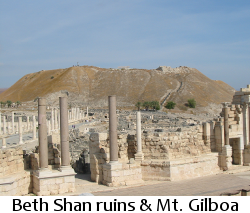 Reprinted with permission from As I See It. AISI is sent free to all who request it by writing to the editor at [email protected]
Reprinted with permission from As I See It. AISI is sent free to all who request it by writing to the editor at [email protected]
How the Holy Land illuminates the Bible like nothing else can & some notable Holy Land travelogues
I found the country [i.e., Palestine, in 1877] and the people pretty much as I expected, but I trust I understand both better than before. My faith in the Bible has not been shaken, but confirmed. Many facts and scenes, which seem to float ghost-like in the clouds to a distant reader, assume flesh and blood in the land of their birth. There is a marvelous correspondence between the Land and the Book. The Bible is the best handbook for the Holy Land, and the Holy Land is the best commentary on the Bible. (Philip Schaff, Through Bible Lands, pp. 383-84)
As a junior in Bible college in 1973, I had the singular opportunity to travel to Greece (including Patmos and Rhodes), Lebanon, Syria, but especially Israel, on a 14-day-long package tour, including air-fare and all fees, taxes and gratuities for the now absurdly cheap price of $600 (my father readily put up the cash for me to go; no better single investment was ever made in my education). I had in class heard the Holy Land referred to as “the Fifth Gospel” since it cast so much light on the events in the life of Jesus, and as a student of the Bible and preacher-in-training, I naturally very much wanted to the see the Holy Land for myself with my own eyes, to walk its hills, smell its air, feel its atmosphere, and hear its sounds.
I took the time to read up in advance on what I was going to see—a couple of brief books on Holy Land geography—which indeed did enhance the experience. Had this modest preparation been doubled and trebled by reading a shelf full of similar books, while I would have seen and understood more, even this would have been no adequate substitute for seeing it for myself. As is invariably the case, the images that developed in the mind’s eye through written accounts were often considerably different from those formed by actually being there. For myself, I was amazed at the utter smallness of the place—smaller than all but the very smallest of U.S. states. I was astonished, for example, to discover that the north end of the Dead Sea was clearly visible at sunrise from the top of the Mount of Olives, or that the entire Sea of Galilee can be seen at once by anyone standing on the hills surrounding it.
There is, then, no adequate substitute for actually being there. That being said, however, I am sure that there is very great value to be had in reading and studying “pilgrim” accounts of visits to the Holy Land, especially those that date to the 19th and earlier centuries, in particular those that came from the pens of trained Bible scholars who had eyes to see and understand what they were seeing. Also of merit are some accounts from professional writers—reporters, journalists, and such—whose very profession is observing and recording.

 Reprinted with permission from
Reprinted with permission from 
Discussion